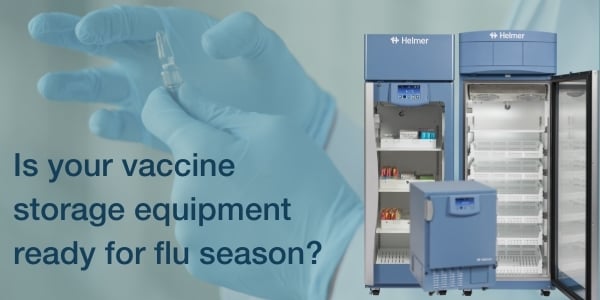
Summer is winding down and providers are preparing for the upcoming flu season and the beginning of flu vaccination efforts. According to the CDC, last year’s flu season saw the highest number of flu vaccine doses ever administered. More than 193 million doses were given, and about 53-54% of adults received a flu vaccine. Experts are expecting more than 190 million doses to be administered during the 2021-2022 flu season.
To get ready for flu season, providers should review vaccine storage equipment and CDC guidelines for vaccine storage and handling. The CDC recommends providers choose purpose-built, stand alone units, designed for storing vaccines and other medical-grade products. These storage units safeguard vaccines by providing reliable, consistent temperatures across multiple locations inside the unit. The following recommendations are also outlined in the CDC Vaccine Storage and Handling Toolkit:
- Monitor the equipment’s temperature using a digital data logger (DDL)
- Calibration testing every 1-2 years or according to the manufacturer’s guidelines
- Conduct routine maintenance for all vaccine storage units and related equipment so your equipment functions at maximum efficiency
Additionally, a new standard for vaccine storage from NSF was published earlier this summer that enables providers to better understand the performance of their vaccine storage units. The NSF / ANSI 456 Standard takes the CDC recommendations a step further by outlining testing and performance criteria to test the vaccine storage unit itself and ensure temperature performance, stability, and reliability across all potential storage locations. Vaccine equipment manufacturers will be able to submit their units for testing and certification to the standard.
It was recently announced that the CDC may recommend additional vaccines for recipients of the Pfizer and Moderna vaccines approximately 8 months after their second dose. This could start as early as September, and providers should be prepared for an increase in vaccines volume and potentially additional vaccine storage units.
OTHER BLOGS YOU MIGHT BE INTERESTED IN...
- Upcoming Webinar | Back to School: Navigating return to school and work amid COVID-19 and Flu Season
- New Standard for Vaccine Storage Published
- Looking Ahead to the 2021-2022 Flu Season and Back to School Immunization
- GX Solutions: Why You Need Professional, Medical-grade Cold Storage
Helmer’s GX Solutions line of pharmacy refrigerators and freezers can help support your facility’s vaccine storage needs throughout flu season. We even offer a Quick Ship program to fulfill immediate needs for additional vaccine storage.




